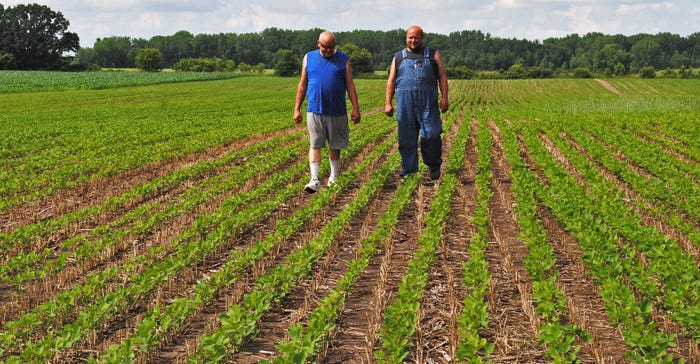
For the past 10 years, Josh Hiemstra has been growing cover crops on his family’s dairy farm near Brandon in western Fond du Lac County, Wis.
“The first cover crop we planted was winter rye,” Hiemstra recalls. “We needed heifer feed. We also wanted to limit soil erosion. Even though we have pretty flat ground, it does wash in places.”
Hiemstra seeded the rye right after he and his dad finished harvesting corn silage. The following spring, they chopped the ryelage in May and planted soybeans.
“Rye works best after corn silage,” Hiemstra explains. “Then plant soybeans, because you don’t have the nitrogen tie-up.”
The Hiemstras own 275 acres and rent an additional 510 acres. They grow 400 acres of corn, 140 acres of alfalfa with a grass blend, 120 acres of soybeans and 25 acres of wheat. They also milk 175 Holstein cows and raise 150 heifers and 120 Holstein crossbred steers and heifers.
Free feed
This spring, the Hiemstras no-tilled soybeans after ryelage.
“We seed rye every year,” Hiemstra says. “You have to manage your forage inventory. If you feed your heifers ryelage, you will get three crops in two years, so you are basically feeding your heifers for free.”
He says rye also controls weeds. “We will probably only have to spray it once,” Hiemstra says, “because the rye keeps the weeds away. I think the soybeans yield 2 to 3 bushels per acre better after rye. It’s easier for the beans to transfer nutrients from the soil.”
Hiemstra, 42, graduated from Laconia High School in Rosendale in 1995. He attended Fox Valley Technical College in Appleton for two years, majoring in facilities and equipment, but he says he acquired most of his knowledge about cover crops from attending meetings and field days, reading articles online, and experimenting with various cover crops on the farm.
Over the years, the Hiemstras have tried several other cover crops.
“We spread manure after we harvested our wheat, and our corn yields the following year were not good,” Hiemstra says. “Now we plant radishes or radishes and barley, and we had 250-bushel corn after that.”
He credits the radishes improving soil tilth with the increased corn yields. “They hold the nutrients from the manure, and when they rot, they give back nutrients to the corn.” He says radishes also attract earthworms and nightcrawlers, which improve soil tilth, too.
More cover
A few times the Hiemstras have planted triticale and radish tops after their wheat is combined and the straw is baled.
“We plant it in early August and harvest it in early October,” Hiemstra explains. “We put it in the silo on top of the corn silage. I’m planning to plant triticale and radish tops on our wheat ground in early August.”
On June 20, he seeded 15 acres of brown midrib sorghum and ryegrass.
“We’ll chop it the end of August for feed for the heifers,” he says. “We might get two cuttings off that this year. We’ll have to be careful of frost in October — sorghum is poisonous to animals if it is harvested after a frost.”
Hiemstra and his dad, Bob, 62, handle milking, chores and fieldwork with help from four part-time employees: Bob’s brother Arlin, Matthew Ludtke, Sam Ford and Scott Kelnhofer, who works on weekends. Kelnhofer’s daughter Clare and Reid Vossekuil help as needed.
The Hiemstras hire a custom harvester to bale their hay in big squares and to combine soybeans, wheat and high-moisture corn, which is stored in a 20-by-80-foot Harvestore.
“The rest we do ourselves,” Hiemstra says.
Cows are milked twice a day in a milking parlor. Their herd averages 77 pounds of milk per cow with 4.1% butterfat, 3.1% protein and a 175,000 cell count.
In addition to storing high-moisture corn in a Harvestore, their forage is stored in three 20-by-80-foot cement stave silos, a 20-by-70-foot silo and a 24-by-90-foot silo. They also rent an ag bagger.
Hiemstra and his wife, Bobbie, have a son, Mason, and a daughter, Cassandra.
To learn more about how the Hiemstras use cover crops to extend their forage inventory and improve soil health and fertility, you can email Hiemstra at [email protected]. Check out the slideshow to see photos of the operation.
About the Author(s)
You May Also Like






